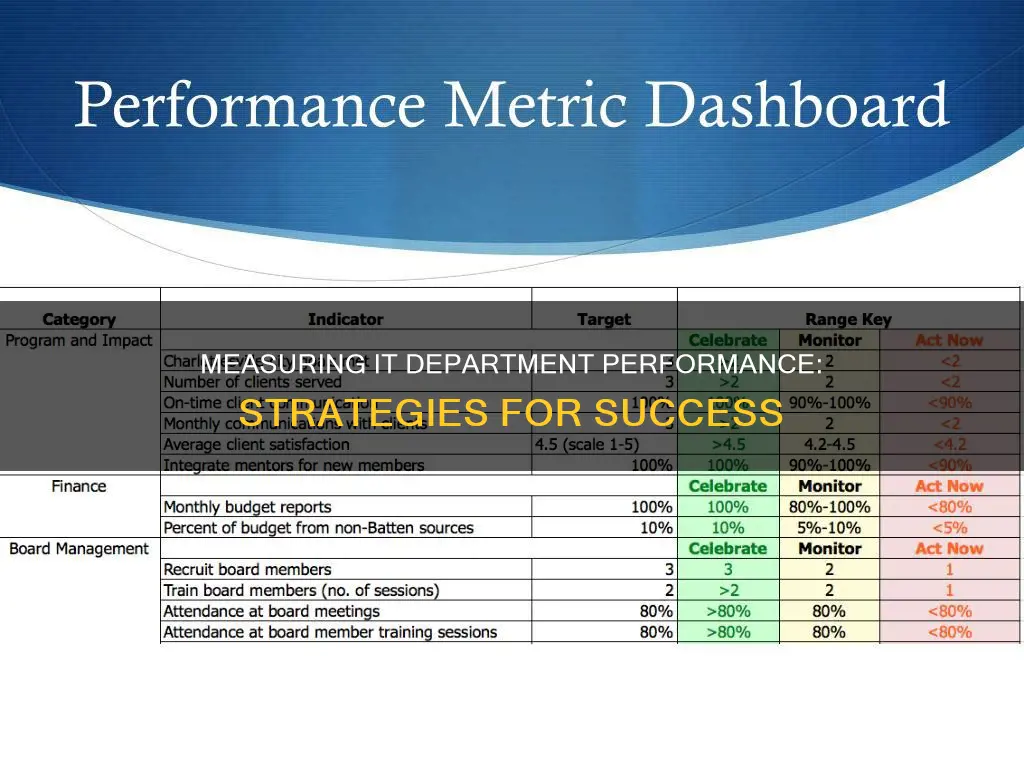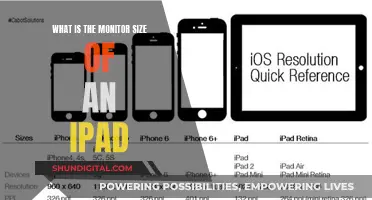
Monitoring the performance of an IT department is a complex but necessary task that can provide valuable insights and help improve efficiency. While there is no one-size-fits-all approach, several methods can be employed to effectively evaluate and enhance the performance of IT teams. This includes setting clear goals and relevant milestones, tracking key performance indicators (KPIs), conducting regular check-ins, leveraging monitoring software, and providing recognition and rewards.
By utilising these strategies, managers can gain a deeper understanding of their IT department's strengths and weaknesses, make data-driven decisions, and create a culture of continuous improvement and employee engagement.
| Characteristics | Values |
|---|---|
| Response metrics | Mean time to respond, mean time to resolve, first call resolution rate, user satisfaction |
| Performance metrics | Infrastructure downtime, network outages, mean time between failures, mean time to failure, frequency of planned and unplanned outages, network capacity, online application performance, online application availability, defect containment |
| Organizational metrics | Workforce productivity, overtime hours, agent satisfaction |
| Cost metrics | Capital and expense cost, cost per user, cost per ticket, cost per unit asset |
| Monitoring techniques | Project check-ins, visual monitoring, time-tracking software, individual employee check-ins, task management software |
What You'll Learn
- Response metrics: how effectively the IT department resolves issues for users and the whole system/network
- Performance metrics: how well the IT department supports the company's technological needs
- Cost metrics: tracking financial metrics to measure IT efficiency
- Visual monitoring: physically observing employees in action
- Task management software: using cloud-based tools to track employee progress and performance

Response metrics: how effectively the IT department resolves issues for users and the whole system/network
Response metrics are a crucial aspect of monitoring the performance of an IT department, providing insights into how effectively the team resolves issues for individual users and the entire system or network. Here are some key response metrics that can be leveraged to evaluate the effectiveness of IT operations:
- Mean Time to Respond (MTTR): This metric tracks the average response time of the IT department to a newly opened ticket or performance issue. It is a valuable tool for assessing team member efficiency and overall team performance.
- Mean Time to Resolve: This metric measures the time taken from the initial report of a problem to its ultimate resolution. In a service-focused context, this would entail tracking the time from the opening of a ticket to its closure, with the issue being resolved.
- First Call Resolution Rate: This metric evaluates the percentage of tickets or requests that are successfully addressed during the customer or user's initial call to the IT department.
- User Satisfaction: Gaining feedback from users, such as ratings or comments after their tickets are closed, helps assess the quality of work delivered by the IT department. This metric is essential for understanding user experiences and identifying areas for improvement.
- Mean Time to Contain (MTTC): In the context of cybersecurity, MTTC refers to the average time taken to contain a security threat and prevent further damage. It encompasses detecting, diagnosing, and responding to the threat.
- Mean Time to Detect (MTTD): MTTD calculates the average time taken to identify an incident and initiate a response. Lower MTTD values indicate a more efficient detection process.
- Mean Time to Identify (MTTI): MTTI measures the time taken to diagnose an attack after it has been detected, including identifying the nature of the incident and determining the necessary response.
- Mean Time to Respond (MTTR): This metric, in the context of cybersecurity, refers to the time taken to act on the knowledge of the incident and implement measures to contain it.
- Mean Time to Normal (MTTN): Also known as Mean Time to Restore or Resolve, MTTN refers to the time taken to fix any issues caused by the contained threat and restore normal operations for end users.
These response metrics offer valuable insights into the effectiveness and efficiency of the IT department in addressing user issues and maintaining system functionality. They provide a quantitative basis for evaluating performance, driving improvements, and making informed decisions to enhance the overall user experience.
Open-Box Monitor Purchase: Worth the Risk?
You may want to see also

Performance metrics: how well the IT department supports the company's technological needs
Performance metrics are an efficient tool for gathering objective data on the IT department's performance. They can help managers understand the department's progress and make informed decisions about equipment upgrades, network expansion, and service changes. Here are some key performance metrics that can be used to evaluate how well the IT department supports the company's technological needs:
- Infrastructure downtime: This metric tracks the availability of infrastructure elements over a certain period. Calculating it as a percentage can help to understand its impact on productivity.
- Network outages: This metric counts the number of times the network is down within a given period. Tracking this over time can provide a simple way to evaluate the network's resilience.
- Mean time between failures: This metric measures the time from the beginning of one failure to the next, providing insight into the frequency of system failures.
- Mean time to failure: This metric tracks the time from when the system recovers from a failure to the next failure, helping to determine if failures are regular or anomalous.
- Frequency of planned and unplanned outages: This metric, combined with the previous two, can show the network's resilience and the department's overall resolution capabilities.
- Network capacity: This metric measures the load the network can handle, helping to identify when an upgrade is necessary and how well the network handles surges or new users.
- Online application performance: This metric evaluates the performance of the company's online applications and sites, tracking factors such as load times.
- Online application availability: This metric assesses the functionality of online applications, which can be measured in terms of key functions, availability during peak hours, or the percentage of time the application is available.
- Defect containment: This metric is relevant for IT departments that regularly build and release software. It measures the percentage of defects caught and fixed before and after release, helping to evaluate the effectiveness of testing procedures.
By tracking these performance metrics, managers can gain valuable insights into the IT department's ability to meet the company's technological needs. These metrics can inform decisions about resource allocation, upgrades, and process improvements, ultimately enhancing the department's performance and alignment with business goals.
Connecting Multiple Monitors to a Car Radio
You may want to see also

Cost metrics: tracking financial metrics to measure IT efficiency
Tracking financial metrics is important for regular reporting and measuring IT efficiency. Here are some cost metrics that can be used to monitor the performance of an IT department:
Capital and Expense Cost
Tracking the total cost over time is essential to ensure that spending matches the budget. This metric can also be used to calculate other metrics such as cost per user and cost per ticket.
Cost per User
This metric tracks the amount of money spent per user and can be beneficial for measuring efficiencies of scale as a company grows.
Cost per Ticket
The cost per ticket is calculated by dividing the total department costs by the number of tickets resolved over a specific period. This metric provides insight into the department's spending efficiency.
Cost per Unit Asset
This metric measures the cost of maintaining assets such as data storage and individual machines.
Unit Costs vs. Benchmarks
Unit costs refer to the direct costs per unit for key components of IT services. These include client computing costs for devices, storage costs (usually measured per terabyte), and computing costs for established levels of service. Benchmarking unit costs against industry standards and other business units can help identify areas requiring further analysis.
Fixed vs. Variable Cost Ratio
Understanding the fixed-to-variable cost ratio provides insights into the cost structure relative to the organisation's strategy. Moving towards a variable cost structure can enhance agility, flexibility, and scalability to meet changing demands. A deeper analysis of variable costs can also help anticipate the impact of business changes on total costs and budget requirements.
Direct vs. Indirect Cost Ratio
The direct vs. indirect cost ratio helps identify where costs are primarily allocated. This metric, along with utilisation metrics, can quickly reveal opportunities for cost reduction, particularly regarding direct costs associated with poorly utilised resources.
Budget vs. Actuals and Budget vs. Forecast
Budgeting is typically an annual exercise, while forecasting should be done at least monthly. Knowing expected variances between the budget and actual or forecasted amounts is crucial for effective IT management. Identifying variances early allows for proactive adjustments and informed decision-making.
Monitoring JVM Heap Usage: Practical Tips for Performance Optimization
You may want to see also

Visual monitoring: physically observing employees in action
Visual monitoring, or physically observing employees in action, is a crucial aspect of performance management in the IT department. Here are some detailed tips and strategies for effective visual monitoring:
Establish Clear Criteria
Before beginning visual monitoring, it is essential to define the specific criteria you will be assessing. This provides a structured framework for your observations and ensures that you are evaluating employees based on relevant and consistent factors. Some key areas to consider are attitude, timeliness, effort, consistency, ethics, and safety. For example, you might observe if employees are punctual in completing their tasks, demonstrate a positive attitude towards their work, and adhere to ethical guidelines. By having clear criteria, you can make more informed decisions about employee performance.
Conduct Direct Observations
Directly observing employees as they perform their duties is an essential aspect of visual monitoring. This involves watching employees' actions, behaviours, and interactions without them knowing that you are specifically monitoring their performance. This approach helps you gather first-hand information and make your own assessments, rather than relying solely on the opinions of coworkers or customers, which can be subjective. During these observations, pay attention to the criteria you have established and make notes on any relevant behaviours or incidents. For example, you might notice an employee who consistently arrives early, interacts positively with their colleagues, and efficiently resolves technical issues.
Review Additional Reports and Feedback
While direct observations are valuable, it is also important to consider other sources of information about employee performance. This includes reviewing customer emails, feedback forms, or complaints, which can provide insights into how employees interact with clients and the quality of their work. For instance, if a particular employee consistently receives positive feedback from customers, you might decide to give them more autonomy in handling client interactions. Additionally, you can use these external reports to cross-reference and validate your own observations, ensuring a more comprehensive understanding of employee performance.
Identify Hindrances to Performance
Visual monitoring should also involve identifying factors that hinder employee performance. For example, you might notice that an employee is frequently delayed in completing their tasks due to technical issues with their computer or software glitches. By observing these hindrances, you can address the underlying issues and optimise the work environment to support better performance. This demonstrates your commitment to fairness and ensures that employees are evaluated based on their abilities rather than external factors beyond their control.
Provide Objective Evaluations
When evaluating employees based on visual monitoring, it is crucial to focus on objective criteria rather than subjective personality traits. Assessments should be based on observable behaviours and tangible outcomes. For instance, evaluate employees based on their timeliness in submitting work, the quality of their output, or their ability to collaborate effectively with others. Avoid making judgments based on personal characteristics, as this can lead to bias and unfair evaluations. Objectivity ensures that employees are measured based on their skills and contributions to the team.
Offer Feedback and Recognition
Visual monitoring should be a continuous process that involves regular feedback discussions with employees. These discussions strengthen communication, help employees understand your expectations, and provide opportunities for improvement. During these conversations, be transparent about the aspects of their performance that you have observed, and work together to identify areas for growth and strategies for success. Additionally, recognise and reinforce strong performance to boost employee motivation and self-esteem. For example, if you have observed an employee consistently going above and beyond in their role, provide positive feedback and acknowledge their contributions.
Monitoring Web History on Your ASUS Router
You may want to see also

Task management software: using cloud-based tools to track employee progress and performance
Task management software is a digital platform that helps individuals and teams manage their tasks. It offers a structured approach to organizing and prioritizing tasks, and tracking tasks to ensure better collaboration and effective time management.
Cloud-based tools are particularly useful for remote teams, allowing team members to access the platform from anywhere. Here are some examples of task management software with cloud-based tools:
Asana
Asana is a popular task management tool with a user-friendly interface. It offers a variety of features, including task creation, assignment, and tracking. Asana is a good choice for teams that need a flexible and customizable tool. It has a "My Tasks" list, which auto-promotes tasks based on due dates, and allows for the creation of subtasks. Asana integrates with over 100 other apps, including Google Sheets, Figma, Microsoft Outlook, and Gmail.
Trello
Trello is a visual task management platform that uses boards, lists, and cards to organize tasks. It is intuitive and has no-code automation features, making it perfect for managing linear tasks on a smaller scale. Trello integrates with Slack, Google Drive, and Microsoft Teams, and has a free version.
ClickUp
ClickUp is an all-in-one task management tool that supports cross-collaborative teams. It has a user-friendly interface and runs smoothly on all major operating systems. ClickUp offers time-tracking, task automation, communication support, and reporting and analytics features. It integrates with over 1000 apps, including Slack, Gmail, Zoom, Outlook, and HubSpot.
Hive
Hive is a productivity platform that helps teams manage upcoming tasks, assign work to team members, and collaborate within the platform. It offers flexible project layouts, workflow automation, time-tracking, and resourcing. Hive also has a free plan.
ProofHub
ProofHub is a task management and team collaboration software used by teams of all sizes and industries. It offers task assignment, multiple task views, task dependencies, bulk actions, custom fields, task comments, time tracking, file sharing, and collaboration features. ProofHub integrates with Slack, Google Drive, Freshbooks, Dropbox, QuickBooks, and Google Calendar.
Todoist
Todoist is a leading task management tool with a simple interface. It functions as an online to-do list, where users can manage tasks and projects, whether for themselves or as part of a team. Todoist offers subtasks, recurring tasks, commenting, and prioritization levels. It integrates with ClickUp, Asana, and other productivity and time-tracking apps.
Replacing LCD 2243BW Series Monitors: A Step-by-Step Guide
You may want to see also
Frequently asked questions
IT metrics are measurable quantities that can show departmental progress and processes. Any statistic relating to IT department performance can be an IT metric, whether it's related to organisational performance like costs or system performance like network capacity.
Examples of IT metrics include:
- Response time
- User satisfaction
- Infrastructure downtime
- Network capacity
- Cost per user
There is no formal standard for how often IT performance should be measured. Some organisations measure IT performance every few years, while others do so annually or more frequently. It depends on the needs and goals of the organisation.
Monitoring IT performance provides essential analysis and assessments that can inform high-level business tasks such as planning, budgeting, improvement plans, and investments in new technologies. It also helps identify areas for improvement and where the department is successfully meeting its goals.







